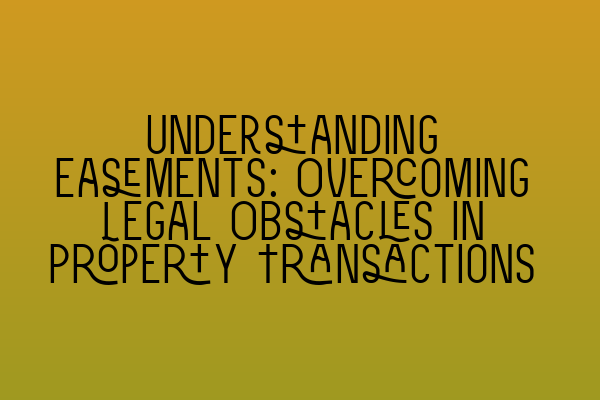Understanding Easements: Overcoming Legal Obstacles in Property Transactions
When it comes to property transactions, there are often legal obstacles that can arise, making the process more complex. One such obstacle is the issue of easements. Understanding easements is crucial for both property buyers and sellers, as they can have a significant impact on the use and enjoyment of a property. In this blog post, we will explore what easements are, the types of easements that exist, and how to overcome legal obstacles related to easements in property transactions.
What are Easements?
In simple terms, an easement is a legal right that allows someone to use another person’s property for a specific purpose. It grants a non-possessory interest in the land, enabling certain rights and limitations to be imposed on the property in favor of a specific person or entity. Easements can be crucial for various reasons, such as providing access to a landlocked property or allowing utilities like water or electricity to pass through one property to reach another.
Types of Easements
There are several types of easements that can be encountered in property transactions. Let’s take a closer look at some of the most common ones:
1. Right of Way: This is perhaps the most common type of easement. A right of way allows someone to pass through another person’s property to access their own property, a public road, or a specific location. It can be either an easement by necessity or an easement by agreement.
2. Utility Easement: Utility companies often require easements to run utility lines, such as electricity or gas, through private properties. These easements ensure the utility provider’s right to access and maintain their infrastructure.
3. Easement of Support: This type of easement grants the right to have a building or structure supported by a neighboring property. It is relevant in situations where the stability and integrity of a structure depend on the support it receives from an adjacent property.
4. Easement by Prescription: Also known as a prescriptive easement, this type of easement is acquired through long-term use of another person’s property without permission. To establish a prescriptive easement, certain elements need to be satisfied, such as open and notorious use, continuous use for a statutory period, and an exclusive and adverse claim.
Overcoming Legal Obstacles in Property Transactions
Now that we have a basic understanding of easements, let’s explore how to overcome legal obstacles related to easements in property transactions. These obstacles can range from disputes over the existence or extent of an easement to concerns about the impact of easements on property value and use.
1. Conduct a Thorough Title Search: Before entering into a property transaction, it is crucial to conduct a thorough title search. This search will help identify any existing easements on the property and ensure that they are properly recorded and do not pose any legal obstacles.
2. Obtain a Property Survey: A property survey can provide valuable information about the boundaries of the property and any existing easements. It can help identify encroachments and potential conflicts that might arise due to easements.
3. Review Easement Agreements: If an easement exists on the property, it is essential to review the easement agreements and understand the rights and limitations imposed. This will help determine any potential impact on property use and enjoyment.
4. Seek Legal Advice: If you encounter any legal obstacles or have concerns regarding easements in a property transaction, it is advisable to seek legal advice from a qualified solicitor specializing in property law. They can provide guidance, negotiate terms, and ensure that your rights and interests are protected.
Conclusion
Understanding easements is crucial when engaging in property transactions. By familiarizing yourself with the types of easements that exist, conducting thorough due diligence, and seeking legal advice when needed, you can overcome legal obstacles related to easements. Remember, knowledge and proper preparation are key to ensuring a smooth and successful property transaction.
For more insights and guidance on legal topics related to property transactions, contracts, and contractual capacity, check out our related articles:
– Understanding Contractual Capacity: Rights and Limitations
– Interactive SQE Mock Tests for Contract Law: Test Your Knowledge
– Join Our SQE Contract Law Webinars: Expert Insights and Guidance
– SQE Prep: Mastering the Essentials of Contract Law
– Contractual Capacity: Understanding Legal Competence in Contracting Parties
At SQE Property Law & Land Law, we are here to assist you with all your property law needs. Contact us today to speak with one of our experienced solicitors and ensure a seamless property transaction.
